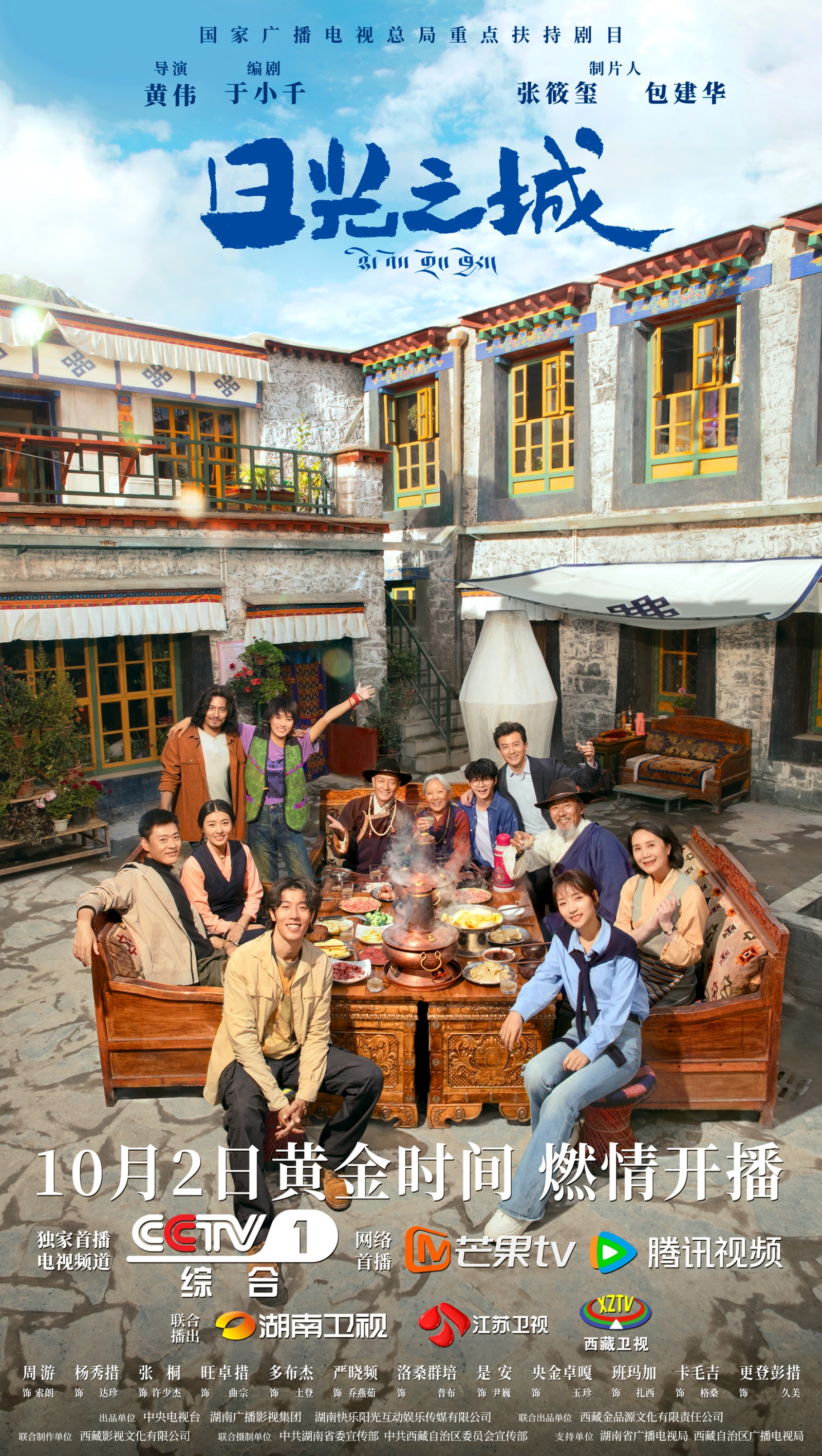
The recently aired TV drama "City of Sunlight" is a rare work focusing on stories from Tibet in recent years. Set mainly in the Barkhor area of Lhasa, the show presents a vivid tapestry of life in the city. The scriptwriter, Yu Xiaoqian, undoubtedly plays a crucial role in this depiction.

Poster of "City of Sunlight"
In the past two years, Yu Xiaoqian has become well-known for the series "A Long Season." When presented with the opportunity to tell a story from Tibet, Yu's initial reaction was one of trepidation. Like many creators facing the unknown, he was acutely aware of the complexity and difficulties involved in a project about Tibet. He candidly admitted that prior to this project, he had never been to Tibet and, like most people, his understanding of the region was superficial and symbolic. However, it was this uncertainty that ignited his curiosity, leading him, after some hesitation, to rise to the challenge.
A project involving Tibet goes beyond merely being a regional theme; it also touches upon sensitive and significant issues of ethnicity and religion. Yu Xiaoqian recognized that appropriately reflecting these elements in the work posed a primary challenge he needed to confront. He knew that even a small misstep in the creation process could result in audience misunderstandings or fail to authentically portray the essence of Tibet.

Still from "City of Sunlight"
In October 2021, Yu Xiaoqian joined a research team on their journey to Tibet. This marked his first close encounter with the region and served as a significant turning point in his creative journey. From Nyingchi to Lhasa and then to Shigatse, he embarked on an in-depth exploration. The stunning scenery of Nyingchi captivated him, with lush vegetation resembling nature's great green treasure, and its similarities to many inland areas offered him a comforting familiarity. As the journey progressed to Lhasa and Shigatse, he profoundly felt the natural changes brought on by altitude, with the urban environment and cultural status presenting starkly different features. His first field trip, albeit somewhat superficial, opened a door to understanding Tibet.
In March 2022, Yu Xiaoqian ventured into Tibet again, this time with clearer objectives and a deeper desire for exploration. He chose to live on Barkhor Street for nearly six months. During this long yet fulfilling period, he and his writing team interviewed over a hundred individuals, mobilizing all contacts and resources at their disposal to comprehensively understand the people living in this land.

Still from "City of Sunlight"
On Barkhor Street, filled with the vibrancy of life, he experienced the local residents' lifestyle. Here, various individuals coexist—native Tibetan natives and "Lahu" migrants from inland areas, people of different ages, professions, education levels, and occupations, each with their own stories. He immersed himself in their lives, visiting homes to understand their living tracks, habits, and routines. He discarded the mindset and perspective of a tourist, striving to envision himself as a local person, feeling their joys and sorrows. He witnessed the local youth's love and pride for their culture and land, feelings so profound they moved him deeply. He also observed the blending of inland and Tibetan cultures here; some young people enjoy traditional Tibetan clothes while also wearing popular brands from the mainland; they drink sweet tea and relish modern coffee and beer. This cultural collision and fusion provided abundant material for his creative work.
In March 2023, Yu Xiaoqian made his third trip to Tibet, primarily focusing on the character development of Suolang, the protagonist of his work. Suolang represents contemporary Tibetan youth, and his entrepreneurial story is a key plot point. However, throughout the previous phases of creation, Yu and his team felt their grasp on this character was not solid enough, unable to pinpoint a firm foundation. They needed to differentiate Suolang's entrepreneurial journey from the entrepreneurship of young people in Beijing and Shanghai, making this character's story distinctly Tibetan.
Thus, he once again delved into the local youth, interviewing various young people with entrepreneurial experiences or those with higher education, who had studied or innovated in Tibet. Through their conversations, he gradually clarified Suolang’s character logic, making his trajectory more coherent. This third trip to Tibet facilitated a smoother creative process for "City of Sunlight." The fourth trip coincided with the commencement of the film shoot, marking the project's official start.
During the creation of "City of Sunlight," Yu Xiaoqian continuously contemplated how to showcase Tibetan cultural traits without falling into the traps of sensationalism or one-sidedness. He recognized the importance of elements like Tibetan opera and traditional noodles in people's lives, as well as the natural presence of religious aspects in local culture. He understood the need to balance the portrayal of religious and ethnic elements without either avoiding them or excessively dramatizing them. Employing an objective perspective, he integrated these elements into the characters and plot, allowing the audience to gain a more authentic understanding of Tibet. He is acutely aware that to truly resonate with viewers, one must focus on the simple relationships and emotions between people, stating, "No matter the differences in regions, human emotions are fundamentally connected."

Still from "City of Sunlight"
Dialogue
Four trips to Tibet, and the script slowly taking shape
Penglai News: How did you get involved with this project?
Yu Xiaoqian: Initially, I connected with this project through a friend, similar to how I got involved with other projects. Upon hearing it was a project involving Tibet, I thought it would undoubtedly be a challenging endeavor. As a screenwriter, working on a project about Tibet necessitates careful consideration of how to address issues of ethnicity and religion. Moreover, I had never been to Tibet before, and my understanding of the region was much like that of the average person—superficial and symbolic—making me feel it posed many difficulties. I initially just knew a little. Then in October 2021, when the General Administration invited a research team for a field trip, I decided to join and see for myself. After going, I realized that this project truly needed to be pursued and began to seriously consider the reasons that drew me to it. A significant part of my motivation was that while it would be difficult, it was also highly challenging, and the scarcity of projects about Tibet was very appealing to me. I initially approached this project with a sense of curiosity and novelty.

Still from "City of Sunlight"
Penglai News: You mentioned you had never been to Tibet before. Was it essential for you to visit multiple times to feel the local culture before the creation process? Which places did you primarily visit during this phase, and what experiences did you have? What impressions did you gain of Tibet?
Yu Xiaoqian: Our entire creative process involved four trips to Tibet, from the scriptwriting stage to filming.
The first trip was in October 2021 when I joined the research group for ten days, traveling from Nyingchi to Lhasa and then to Shigatse. I gained a preliminary understanding of these three locations, noting their distinct characteristics. Nyingchi is beautiful and lush, quite similar to many places in the inland; upon reaching Lhasa, particularly Shigatse, the altitude significantly altered the vegetation, natural environment, urban atmosphere, and cultural state. Nyingchi is home to many inland residents, especially from Sichuan; meanwhile, Lhasa and Shigatse are predominantly Tibetan and showcase stronger Tibetan characteristics. This initial level of exploration was relatively superficial.
In March 2022, we returned to Tibet for a more in-depth exploration for nearly six months. We lived on Barkhor Street and began interviewing over a hundred individuals. We spoke with people born and raised in Lhasa, those who came from inland areas, or those who had studied or worked in other regions and returned. We engaged with individuals from various age groups, professions, and education levels. After each interview, we compiled transcripts and reflected on which stories or life segments we found moving, gradually accumulating material. We stayed through the snowstorm that blanketed Beijing before Lunar New Year until summer. In Lhasa, we produced the first draft of the outline, which received relative approval from experts and scholars, allowing us to proceed with our work back in Beijing.

Still from "City of Sunlight"
Many insights reshaped my previous label-based understanding of Tibet and Lhasa. For example, I learned that competitive exams in Tibet could be even more rigorous than those on the mainland. Initially, we might have thought of Tibet as primarily focused on spiritual pursuits, but later we discovered that parents in Lhasa experience similar anxieties and challenges as those in the inland regions. On another note, we observed the inherent drive among local youth to pursue development in their region. There is also the question of how, despite national aid for Tibet, it can develop more sustainably, equitably, and vibrantly without perpetual reliance on such support. These two aspects left a profound impact on me.
The third trip in March 2022 focused on addressing questions surrounding the character Suolang. Throughout the process, we felt we hadn't found a solid grasp on this character. Each time we consulted with leaders and experts, they inquired how Suolang's entrepreneurship differed from that of young people in Beijing and Shanghai. If selling a type of lamb could also work in those cities, then how is it uniquely a Tibetan story? Therefore, during this third visit, we concentrated on finding a solid anchor for Suolang's character. We interviewed various locals: some had entrepreneurial experience, while others were relatively well-educated or had studied on the mainland or had been innovating locally in Tibet. With each conversation, we untangled Suolang's character logic, clarifying his entrepreneurial path and making the entire scriptwriting process substantially smoother.
The fourth trip was in June 2023 when we commenced filming. Based on the production team's shooting requirements, we reviewed the script with the director from the beginning before making necessary adjustments for filming.

Still from "City of Sunlight"
The uniqueness of youth entrepreneurship in Lhasa
Penglai News: How does youth entrepreneurship in Lhasa differ from that in Beijing, Shanghai, and other areas? What do you believe are the primary distinctions?
Yu Xiaoqian: I think there are two main aspects. One is the common pursuit of general success (selling well and making profits), which is similar for all. The other difference is that the young people in Lhasa, including the few we interviewed, carry a profound sense of love and pride for their ethnic identity, culture, and the land where they live. Many beautiful and niche products exist there, but why are they so underdiscussed? For example, the best-selling products on the streets of Lhasa aren't even locally produced—the beef comes from Qinghai, and saffron from Iran. While we have many excellent products, they don't achieve their potential in sales or scale. Suolang’s selling of Gongba lamb occurs in a county at an altitude of over 4,000 meters in Shigatse, where the survival conditions are harsh, yet local herders diligently farm, graze, and raise sheep, although their income rarely matches their efforts; a sheep could fetch around 2,000 yuan on-site but could sell for 2,500 to 3,000 yuan on the dining tables of Beijing and Shanghai after processing and transportation.
Throughout Suolang’s entrepreneurial journey, his motives extend beyond mere profit and recognition; he is fueled by pride and love for his resources and culture, eager for the world to know the value of what they possess. This idealism distinguishes Suolang and a cadre of young individuals like him from their peers in mainland entrepreneurship.


